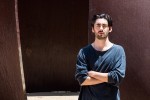Sebastian Moraga dove headfirst into the California art scene six months ago, mingling with visionaries at music concerts and neighborhood bodegas to create his most recent artwork.
The fourth-year world arts and cultures student displayed his project “MOVEMENT JOURNAL: Identity, Neighborhood Change, Interdisciplinary Arts” at “InSight,” a senior showcase for students in the world arts and cultures/dance department, on Friday and Saturday. Over the course of six months, Moraga developed the 36-page journal composed of photographs, interviews and essays encompassing the narratives of creatives throughout California.
“The main thing I learned in this project was … how slow it is to be the sole creator of something,” Moraga said. “I see magazines that have 100 contributors for a 150-page magazine, and at first I questioned, ‘How on Earth are there that many contributors?’ But now I know.”
Moraga said his project is a hybrid between an art book, magazine and zine, and presents a combination of wide-ranging topics, from poetry that explores race and masculinity, to early 2000s-inspired fashion drawings, all the while maintaining a minimalist design. Looking at the vibrantly hued, clean-cut geometric forms that complement textual passages on glossy pages, Moraga said viewers might not suspect the journal’s convoluted creation process.
Originally, Moraga said he intended the project to be a personal novella about familial relations and his mixed Chilean, English and American cultural identity. But as he met with and connected to other creatives, the project evolved to convey their struggles, successes and artistic trajectories instead.
“The whole project became a mixture of me networking, making friends and then watching artists doing things that I don’t even think about,” he said.
During the curation process, Moraga watched a designer sew for 30 hours over a two-day period to complete a stylized leather jacket. He said the energy artists channel into their work inspired him to cover their stories and forge connections to support their challenges and celebrate their efforts.
The journal features five artists, including Steven Cheung, a Los Angeles-based rap and pop music producer who plans the monthly music event “Good Alibi” in Echo Park. In his interview with Moraga, Cheung discussed the aims of “Good Alibi,” as well as the challenges of surviving as a musician in Los Angeles. The honest content makes Moraga’s journal honest and relatable, Cheung said – its inclusion of a range of artists makes it an accurate and intimate account of contemporary creative issues.
“The journal is relevant because the artists involved are all people who are making a lot of sacrifices for their art and struggling for their art to some degree,” he said. “By building relationships with all the people he interviewed, he was able to get a more vulnerable side to them that they conveyed to him as a friend, which makes it more valuable by nature.”
Another project Moraga chronicled in his publication is Clinton Hughes’ “Prototype Sessions.” Hughes, a Los Angeles-based fashion designer and DJ launched the multisensory experience event, which encourages contact with other cultures through food, drink and music, in Seattle.
“I think this being a college publication, it can reach a lot of students that have come from different cultures, neighborhoods, suburbs or urban environments,” Hughes said. “For people who are not hip to the scene or about to transition from the college campus into the big world it’s nice to have your ear on the pulse of what’s going on.”
Moraga said he included “Prototype Sessions” in his project because of the program’s conscious efforts to create an inclusive place for people of various cultures, as well as its collaboration with underrepresented DJs to create a safe space for people of all races and sexualities, Moraga said.
Moraga said the project was an enriching opportunity for a hands-on and involved learning experience, since he was wholly responsible for both sourcing artists and designing the journal. He put his curatorial skills to the test through coordinating and presenting artists’ stories in a publication, a practice he said he developed at UCLA and plans to continue after graduation. Moraga said he is considering continuing the production of his art journal and unfolding it into biannual publications, providing consistent outlets to feature the stories he collects and documents.
“As a person who has grown up in the arts and loves the arts, I never thought I’d be creating (art) physically because I like people more,” he said. “But that’s exactly what this project is – it’s about people.”
